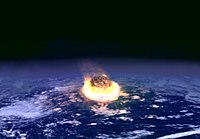
Photo from wikipedia
Abstract Benthic foraminifera are the most common meiofaunal unicellular deep-sea biota, forming skeletons used as proxies for past climate change. We aim to increase understanding of past non-analog oceans and… Click to show full abstract
Abstract Benthic foraminifera are the most common meiofaunal unicellular deep-sea biota, forming skeletons used as proxies for past climate change. We aim to increase understanding of past non-analog oceans and ecosystems by evaluating deep-sea benthic foraminiferal responses to global environmental changes over latest Cretaceous through Oligocene times (67–23 million years ago). Earth suffered an asteroid impact at the end of the Cretaceous (~instantaneous; 66 Ma), episodes of rapid global warming during the Paleocene-Eocene Thermal Maximum (PETM; ~56 Ma) and other hyperthermals (millennial timescales), followed by gradual, but punctuated cooling (timescales of hundred thousands of years) from a world without polar ice sheets to a world with a large Antarctic ice sheet. Here we present the first compilation of quantitative data on deep-sea foraminifera at sites in all the world's oceans, aiming to build a first unique, uniform database that allows comparison of deep-sea faunal turnover across the uppermost Cretaceous through Paleogene. We document variability in space and time of benthic foraminiferal diversity: lack of extinction at the asteroid impact even though other marine and terrestrial groups suffered mass extinction; major extinction at the PETM followed by recovery and diversification; and gradual but fundamental turnover during gradual cooling and increase in polar ice volume (possibly linked to changes in the oceanic carbon cycle). High latitude cooling from ~45 Ma on, i.e., after the end of the Early Eocene Climate Optimum (53.2–49.2 Ma), may have made the middle Eocene a critical period of several millions of years of faunal turnover and establishment of latitudinal diversity gradients. This compilation thus illuminates the penetration of global change at very different rates into the largest and one of the most stable habitats on Earth, the deep sea with its highly diverse biota.
Journal Title: Global and Planetary Change
Year Published: 2020
Link to full text (if available)
Share on Social Media: Sign Up to like & get
recommendations!